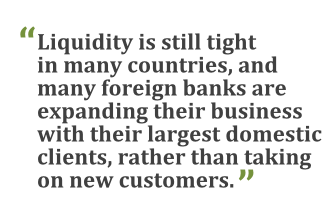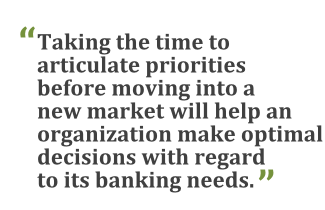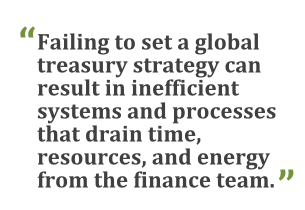If we needed any more proof that a successful business today isa global business, consider a recent Bank of America Merrill Lynchsurvey of U.S.-based middle market companies. In the 2013 CFO Outlook Midyear Update, more than three out of fourexecutives said their companies are doing business internationally.That figure is even more incredible when you consider that 18months earlier it was only 54 percent. Clearly, internationalmarkets have been important to these companies' revenue growthduring the economic recovery. And the number of midmarket firmslooking to grow globally may continue to climb, as many of thebusiness conditions necessary for expansion—such as access tolow-cost credit—remain stronger than they have been in yearspast.
|At the same time, the risks inherent in doing business overseasremain significant. It is vital for a company's leaders to decideon a cohesive corporate strategy before entering internationalmarkets. By taking into account all of the risks and opportunitiesthat overseas expansion might entail, an organization can reduceits borrowing costs, optimize its working capital and liquiditystructure, and facilitate investment activity—all while navigatinglocal clearing systems and currencies.
|Access to Capital
|For many midmarket companies, the first consideration whenlooking at doing business overseas is figuring out how to accesscapital abroad. Although borrowing costs remain very low worldwide,raising capital in a foreign country is very different than takingout a loan in the United States. Liquidity is still tight in manycountries, at least on a bilateral basis, and many foreign banksare working to build their balance sheets by expanding theirbusiness with their largest domestic clients, rather than taking onnew customers. Multinational corporations' subsidiaries sometimeshave difficulty accessing international capital markets, so capitalcan be a serious concern in a push toward global growth.
|Global credit facilities are often attractive to U.S.-basedbusinesses that are growing abroad because they extend credit basedon the standing of the business overall, its financial performance,and the financial strength of the parent company. This isparticularly important for syndications, as it leverages NorthAmerican banking relationships for a global benefit. Such anarrangement also simplifies global borrowing; the entire companyhas one master credit document with a banking counterparty. Termsand conditions are harmonized companywide, which leads tosimplified execution.
Consider a U.S.-based company's various options for structuringfinancing for business units operating in two Europeancountries—France and Italy, for example. One option would be tosecure independent financing to fund the working capital needs andcollateral assets in each country. This would require two sets offinancing documents, two sets of compliance rules, and two teams tokeep the projects going.
|An alternative would be to establish an organizational structurethat includes a principal company in a credit-friendly country,such as the Netherlands, which holds all collateral assets for bothsubsidiaries. In this scenario, the businesses in France and Italywould be converted into tolling operations that receive a fee fromthe holding company for operating expenses; all their cash inflowsand outflows—including inventory purchases, operating expenses,financing expenses, and capital expenses—would go through the Dutchholding company. This arrangement might have long-term benefits interms of simplifying the credit structure of the multinationalorganization, and it might provide better terms for borrowing forthe French and Italian companies. However, it's worth noting thatone recent trend in international borrowing is the tightening ofglobal credit requirements, as a result of many nations' increasedscrutiny of the banking industry.
||A multinational company that is trying to determine the best wayto structure financing around the world needs to start by analyzingthe strategic priorities for its overseas ventures. It shouldquantify the amount of capital it needs to fund each priority andrank them in order of importance. These strategic priorities shouldinclude funding day-to-day operations, funding growth and strategicinvestments, and optimizing working capital liquidity. Gainingoperating efficiencies, protecting margins, and managing volatilityand financial risk are also priorities for most businesses. Becauseevery company and every country is different, taking the time toarticulate corporate priorities before moving into a new marketwill help an organization make optimal decisions with regard to itsbanking needs.
|Cash Management and Liquidity
|Once a company has secured a source of capital for a subsidiaryin another country, its next major treasury challenge is toestablish a process by which the corporate entity can maintain fullvisibility into how much cash the global operation has on hand atany time, as well as where the funds are located. New bankingregulations make it more important than ever before to consolidatetreasury activities as much as possible. Basel III is designed toensure that banks have enough cash on hand to cover their loans, achange that could add more complexity to global liquiditymanagement.
For many midmarket businesses, technology can provide therequisite visibility. Single Euro Payments Area (SEPA) software can improvetransparency throughout the Eurozone and beyond. There are also standardized, bank-agnosticsolutions, as well as single-access platforms and any-to-any fileintegration. These tools—which are generally offered by largerglobal banks—enable companies to track their currencies through afamiliar user interface.
|Of course, optimizing visibility requires process improvementsas well. An integrated payment and risk management policy can help acompany centralize decision-making, maximize liquidity, and makefull use of a technology solution that integrates multiple paymentchannels.
|One unfortunate tendency among companies that are expandingglobally is avoidance. Treasurers often avoid making changes toexisting systems because they don't want to have to change the waythey perform basic treasury functions. That usually translates intoan insistence on being paid in dollars. But using dollars to payfor goods in foreign countries costs 5 percent more, on average,which runs counter to the treasury goal of maximizing receipts.
|Although most multinational corporations benefit fromcentralizing treasury processes, it is important to know the localrules and customs in each nation in which the company operates, andto think broadly about the opportunities in every jurisdiction. Forinstance, there are times when an organization might adopt acurrency hedging strategy in order to gain certainty around thecosts it incurs in the course of its daily operations. At othertimes, a company might engage in the same type of cross-currencyswap with the goal of favorably affecting its interest raterisk.
||Consider a U.S.-based business that wants to expand overseas byacquiring a company in the United Kingdom. The parties wouldset the acquisition price in British pounds, so a hedging strategythat maximized flexibility while minimizing obligation would bevital to the acquiring organization. For some pre- andpost-acquisition expenditures, paying in the local currency andthen hedging to mitigate foreign exchange (FX) risks would becritical, especially to offset the cost of unique, sometimesexpensive, goods and services such as legal fees, advisers' fees,and travel expenses for executives. In other cases, the acquiringcompany would want to use an integrated multi-payment channel toexecute FX transactions, especially if the acquired companyreceives payments in British pounds via numerous smalltransactions.
Having one channel that can process different denominationsallows for greater control and centralization of the treasuryfunction. This can help lower costs by consolidating activitieswith a single group of personnel. And by using one set of internalprotocols to manage the currency, including the FX transactions,business leaders can achieve greater visibility into day-to-daymanagement of the company. They can also more quickly identifyissues to address and favorable opportunities to exploit.
|There is no one-size-fits-all strategy for navigating globalclearing systems and currencies. However, a cohesive strategy—alongwith best practices to consolidate the activities within theorganization—allows companies to optimize their working capital andleverage short-term cash across the different regions in which theyoperate. Treasurers can keep control of global cash management atcompany headquarters, maintain international account information inone place, and consolidate accounts receivable.
|Moving Forward—and Going Far
|Taking advantage of international growth opportunities presentschallenges, but many midsize companies are taking the leap into newcountries or moving deeper into international expansion. To besuccessful, they must have an overarching strategy for securingcapital and managing liquidity abroad. Failing to set a globaltreasury strategy—instead, simply exporting the processes andtechnology that the treasury team uses for North Americanoperations—can result in inefficient systems and processes thatdrain time, resources, and energy from the finance team. That isnot only unfortunate, but also potentially hazardous to thebusiness, as the processes cut into the time and energy the financeteam should be investing in making the expansion and acquisitionsuccessful.
|Several technology tools are available to make it easier formidmarket businesses to explore and execute on a global strategy.And companies that want to expand overseas should make sure theirfinancial partners have the strength and resources to provide afull range of treasury, cash management, and liquidity solutions.That will help set them squarely on the path to achieving asuccessful international profile.
|—————————
| Galen Robbins is headof Global Commercial Banking Transaction Services at Bank ofAmerica Merrill Lynch. In this role, he oversees the delivery oftreasury and liquidity solutions to commercial and institutionalclients across the United States and Internationally.
Galen Robbins is headof Global Commercial Banking Transaction Services at Bank ofAmerica Merrill Lynch. In this role, he oversees the delivery oftreasury and liquidity solutions to commercial and institutionalclients across the United States and Internationally.
Complete your profile to continue reading and get FREE access to Treasury & Risk, part of your ALM digital membership.
Your access to unlimited Treasury & Risk content isn’t changing.
Once you are an ALM digital member, you’ll receive:
- Critical Treasury & Risk information including in-depth analysis of treasury and finance best practices, case studies with corporate innovators, informative newsletters, educational webcasts and videos, and resources from industry leaders.
- Exclusive discounts on ALM and Treasury & Risk events.
- Access to other award-winning ALM websites including PropertyCasualty360.com and Law.com.
*May exclude premium content
Already have an account? Sign In
© 2024 ALM Global, LLC, All Rights Reserved. Request academic re-use from www.copyright.com. All other uses, submit a request to [email protected]. For more information visit Asset & Logo Licensing.







